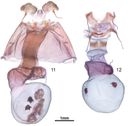Euchaetes
Euchaetes
Classification
- Phylum: Arthropoda
- Subphylum: Hexapoda
- Class: Insecta
- Order: Lepidoptera
- Superfamily: Noctuoidea
- Family: Erebidae
- Subfamily: Arctiinae
- Tribe: Arctiini
- Subtribe: Phaegopterina
- Genus: Euchaetes
Pronunciation
How to pronounce Euchaetes: /juːˈkeɪtiːz/
These audio files are automatically generated. While they are not always 100% accurate, they are a good starting point.
Images






Summary
Euchaetes egle, also known as the milkweed tiger moth, belongs to the Erebidae family. This species specializes in feeding on milkweeds and dogbane, and is notable for its distinctively hairy larvae and chemical defenses acquired from its host plants.
Physical Characteristics
Wings are grayish, abdomens are hairy and yellow with a row of black dots on their dorsum. Mature caterpillars may grow as long as 35 mm.
Identification Tips
Look for the distinctive tufts of black, white, and orange (or sometimes yellow) setae on later instars of the larvae. Adults emit ultrasonic clicks from their tymbal organs when threatened.
Habitat
Commonly found in areas where milkweeds and dogbane grow, including fields and roadsides during mid to late summer.
Distribution
Southern Canada to Texas and Florida in North America.
Diet
Larvae primarily feed on milkweeds (Asclepias spp.) and sometimes on dogbane (Apocynum spp.).
Life Cycle
One generation per year in the north, and two or more generations in warmer southern regions.
Reproduction
Females lay eggs in masses on the undersides of leaves. Eggs hatch into larvae that are gregarious in early instars.
Predators
Predated by bats, which are deterred by the moths' chemical defenses of cardiac glycosides.
Ecosystem Role
As a herbivore, it plays a role in the ecology of milkweed and dogbane plants, impacting their population dynamics.
Collecting Methods
- Light traps
- Visual surveys of host plants
Preservation Methods
- Pinned specimens
- Dry storage of cocoons
Misconceptions
Some may confuse the unpalatability of this moth with that of other common moths, but Euchaetes egle's chemical defenses make it distasteful to many predators.
Tags
- Euchaetes egle
- milkweed tiger moth
- Erebidae
- caterpillar
- chemical defenses